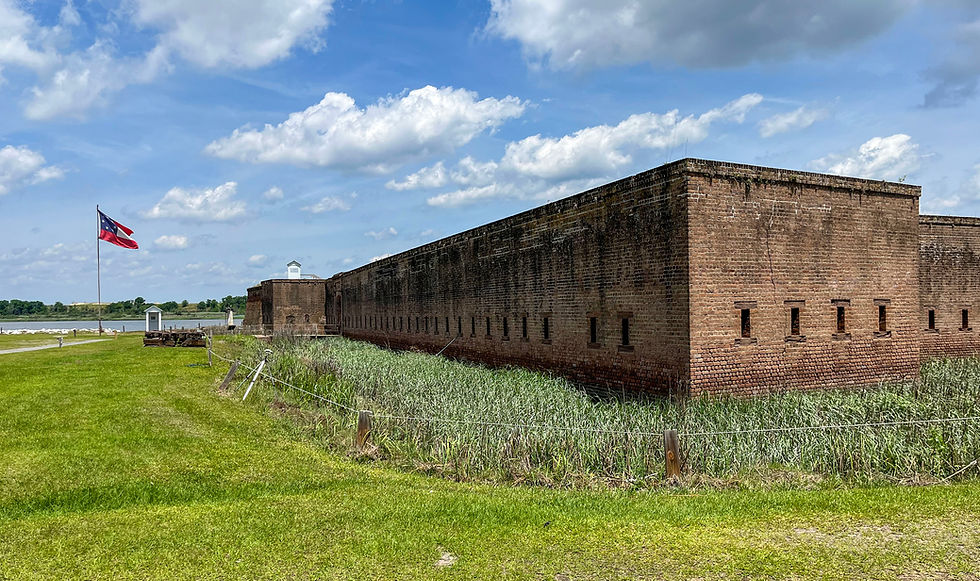Rosewell Ruins
- Tim Murphy

- Apr 8, 2017
- 3 min read
Updated: Apr 24, 2021
Once described as the "most beautiful house in Virginia," Rosewell Mansion epitomized the power and wealth of the Tidewater region for nearly two hundred years. Today, only the hollow brick shell of this once-magnificent structure remains. What's left stands as a testament to Virginia's First Families, the lucrativeness and exploitation of the plantation industry, and colonial marvel.

Rosewell was constructed in the back country of Gloucester County in 1725 and completed in 1738 under the direction the Page family. Mann Page I started the project; however after his death in 1731, his son, Mann Page II, saw its completion. The final product was a massive 12,500 square-foot mansion with three floors and a cellar. There were 33 rooms and 17 fireplaces in the home and two large wooden cupolas flanking either side of the building. All of this presided over 3500 acres of farmland. Mann II's son, John Page (who was Virginia's governor from 1802-1805), attended the College of William and Mary at the same time Thomas Jefferson did. It has been recorded--from letters and Jefferson's own memoirs--that Jefferson frequented Rosewell during vacation periods and that he and Page were quite good friends.
The extravagance of Rosewell was hard to maintain. Although the Page's plantation grew bounties of tobacco and other goods, it barely covered building costs and property taxes. To make matters worse, market values of tobacco plummeted in 1720 and again in 1760, leaving the family in debt. In order to keep the mansion in their possession, they had to sell off 800 acres of their land. John Page continually struggled to maintain Rosewell up until his death in 1808. Despite the economic hardships, the plantation was incredibly self-sufficient, only needing imports for coffee, sugar, and tea. Otherwise, they had enough crops and livestock to support the family and the nearly 400 slaves who toiled the grounds.
The Pages eventually sold Rosewell in 1836 to a man named Thomas Boothe, who basically stripped the home of its wood fixtures, marble, and bricks and sold them as parts for a profit. By the time Rosewell passed to its next owner in 1847, it was in quite the state of disrepair. In 1853, the Deans family bought the property and it remained in their possession for over 125 years. They repaired the home as best they could and frequently used the grounds for social gatherings and parties. It wasn't until March 24, 1916 that Rosewell caught fire and burned to the ground, leaving only the exterior walls and the chimneys standing. The grounds were abandoned for over 60 years, leaving the site overrun by vegetation and eroded by weather. In 1979, the site was handed over to the Gloucester Historical Society, who continue to work to this day to maintain the site's structural integrity.
When I arrived at Rosewell, I first took a look at their indoor exhibit. On display were some of the relics and artifacts recovered from the property and date from the pre-colonial era (Indian artifacts) to the early 20th century. There were also paintings and pictures of Rosewell throughout the years, which was pretty cool to see how it changed over time.

Next up were the ruins themselves. I had goosebumps driving up to the site, seeing the brick columns peeking through the trees. Just imagine what this placed looked like in its prime. The first side of the building I viewed was the the North Facade. Originally, this side of the building had a staircase of imported white marble to the front door and each side of the building was flanked by two service buildings connected by covered walkways. Additionally, a vaulted cellar entrance was constructed underneath the staircase. On the side of the West Wall is a trail that leads to the old ice house. The above-ground structure no longer exists, but a massive 20-foot hole lined by brick remains.
Walking around the building, I found myself at the South Facade, which was the location of the formal gardens. Adjacent to that is the East Pavilion Wall. Here you can see the towering palladium-style window frame that would have provided a great view to those walking up and down the grand staircase. Across from the East Wall was the location of the Page Family Cemetery.
I can honestly say that this is one of the coolest places I've visited thus far. The story behind these ruins is nothing short of incredible. It's also really neat to think that you're walking around the same grounds founding fathers such as Thomas Jefferson and John Page once walked. If you're ever in the Gloucester area, put this place on your to-do list. It's a great addition to any trip and a very nice picnic spot I might add. Additionally, the site is self-guided, so you can explore the grounds at your own pace. For me, this trip took about an hour. Again, I cannot stress it enough...go visit Rosewell!












